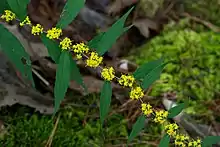| Solidago caesia | |
|---|---|
 | |
| Scientific classification | |
| Kingdom: | Plantae |
| Clade: | Tracheophytes |
| Clade: | Angiosperms |
| Clade: | Eudicots |
| Clade: | Asterids |
| Order: | Asterales |
| Family: | Asteraceae |
| Genus: | Solidago |
| Species: | S. caesia |
| Binomial name | |
| Solidago caesia | |
| Synonyms[1] | |
Solidago caesia, commonly named blue-stemmed goldenrod, wreath goldenrod,[2] or woodland goldenrod,[3] is a flowering plant native to North America.
Description
Key identification features include a dark, wiry, blue or purple stem, and flower heads in the leaf axils instead of in a large array at the top of the plant.[3] Prefers medium to part shade, and can often be found in wooded areas.[4]
Distribution
It grows in the central and eastern parts of the continent from Manitoba east to New Brunswick, south as far as Florida and eastern Texas.[5][6]
Galls
This species is host to the fillowing insect induced galls:
- Asphondylia silva
- Asteromyia carbonifera (Osten Sacken, 1862)
- Gnorimoschema gallaeasterella (Kellicott, 1878)
References
- ↑ "Solidago caesia L." World Flora Online Consortium. Retrieved 23 October 2020.
- ↑ Missouri Botanical Garden Gardening Help, Solidago caesia
- 1 2 Flora of North America, Solidago caesia Linnaeus 1753. Blue-stem or woodland or wreath goldenrod , verge d’or bleuâtre
- ↑ Hilty, John (2017). "Illinois Wildflowers Blue-Stemmed Goldenrod, Solidago caesia, Aster family (Asteraceae)". Illinois Wildflowers. Retrieved 22 September 2018.
- ↑ United States Department of Agriculture Plants Profile
- ↑ Biota of North America Program 2014 county distribution map
This article is issued from Wikipedia. The text is licensed under Creative Commons - Attribution - Sharealike. Additional terms may apply for the media files.